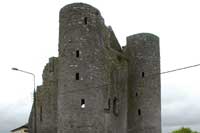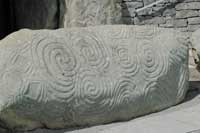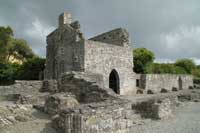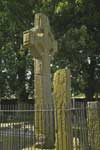
Travelogue
Photos
Today
Tahmon Church
Delvin Castle
Donomogue Round Tower
Howth
Newgrange
Mellifont Castle
Mellifont Abbey
Monasterboice
Slane Castle
Tintain
ieland
Travelogue, Day 20
We're going to make a big loop today, since we decided after dessert last night to spend another night at Tintain. It's not very expensive, the food is fabulous, and the king-sized bed is a nice addition for very-tall Mark.
Most travel gurus and travel sites recommend picking a "base of operations" wherever you go and staying in one place for a few days or a week, foraying out into the world for day trips from your main base. This does give you a more solid feel for the area, and you get very familiar with your home-away-from-home. All well and good, but this also limits your excursions during the day to places that can be reached in half a day's travel so you can get back. This is definitely not not we travel -- we usually plan a rough route in some general direction (in this case, "clockwise round Ireland") and other than having a rough timeline so we make some sort of progress, we don’t' really stay in one town more than once. We start to feel a bit like itinerant nomads, but we also don't stagnate in one area. I think if we picked a hotel somewhere, we'd never go more than a few miles away and miss so much of the fabulous stuff we see.
It's not for everyone, of course. We live out of the car most of the time (although we do not sleep in it), and we probably drive more than some people would like to do on vacation. It works because we don't pack much, don't have a ton of "stuff" that has to go with us everywhere (I can't imagine changing hotels every night, for example, if I carried the sheer amount of beauty supplies and hair stuff that my sister does. We meet a ton of people, and we play the "where shall we end up today" game every afternoon. Some of the B&Bs/hotels we find are amazing places, others are stunning (and not in a good way). Some towns are warm and welcoming and the pub is a great place to hang out, others are insular and suspicious of tourists. But that's half the fun for us. So we move on every night to the next town down the road -- except in rare cases where we really want to stick around for some reason.
The caramel apple crisp at dinner and the omelet at breakfast were reason enough to return to the hobbit-hole B&B.
Day Tripping
 So, our plans today are a big loop that brings us back here for dinner. We are close to Newgrange and the neolithic mounds there. Of course, on the way there, we were sidetracked by a few other sites. Heading out through Crookedtree again (great town name, eh? Even if we didn't’t' see any crooked tree. Hmph) I finally find the castle that was implied by the dot on my map - Taghmon church. It really is a church, although it looks like a small fortified tower - my notes say that it was a fortified residential tower house and later the church bits were added and consecrated. It's locked up tight as a drum, though, and no note to suggest that we can get the key from anyone. There is a placard with information about the church on it, though, which suggests that it is indeed a visit-able site. Maybe our timing was off.
So, our plans today are a big loop that brings us back here for dinner. We are close to Newgrange and the neolithic mounds there. Of course, on the way there, we were sidetracked by a few other sites. Heading out through Crookedtree again (great town name, eh? Even if we didn't’t' see any crooked tree. Hmph) I finally find the castle that was implied by the dot on my map - Taghmon church. It really is a church, although it looks like a small fortified tower - my notes say that it was a fortified residential tower house and later the church bits were added and consecrated. It's locked up tight as a drum, though, and no note to suggest that we can get the key from anyone. There is a placard with information about the church on it, though, which suggests that it is indeed a visit-able site. Maybe our timing was off.
We detoured a little bit through Delvin and view the very interesting castle in town. Two of the original four circular towers are still in place, and the thin keep towers over the main road and right next to row of shops. It's not accessible, really, but it towers over the block-long stretch of 'town". Next to it is a ruined church, as well, with ornate carvings on the doors and windows that we can see. There's a sign on the castle to identify it, but that's about it. I can't see any way to get into the back side of the castle wall and see more of the tower, although I did sidle around a few buildings to see if there was a gap in the wall or access through some alley. No luck. This happens a lot.
I like to visit the round towers. Not only are they a quintessentially Irish sort of architecture (only a few exist outside of Ireland --3 in Scotland and one on the Isle of Man), they are easy to see towering over the towns so it's easy to track them down. There are about 120 known round towers in Ireland, in various states of repair.
It's also easy to map out the sites where they are found. They always face the west doorway of the church that are associated with, so it's possible to figure out what the site looked like, even if there aren't many foundations still in place. It's likely that the towers were used for storage or as an equivalent to the english church bell tower. (In fact, The Irish word for round towers, cloictheach, literally means "bell house"). Any stories of hiding from Viking raiders in the towers is likely made up.
The round tower at Dromoleague is visible for miles and the little bits of the church that are left are interesting for a very quick visit.
Neolithic chamber toms and mounds
 All the guide books warn that it might not be possible to get into the tombs at Newgrange or Knowth, as there are always tons of tourists and they have limited access via the Bru na Boinne visitor center to ensure an orderly visit. The whole place is a bit heavy on process - show up, try to get assigned to a tour(s), get a sticker for what bus to be on, then pay for the tickets and wait around. We arrived at 12 and were lucky enough to get on a tour to Knowth at 12:45 and then to Newgrange at 2:!5 (Don't think this is going to be a short visit!). Not boo bad. There were ten or more busses in the parking lot when we arrived, and you have get a ticket from the visitors center before they'll let you on in. Although, I think if you have a Heritage card (like we do) you can just walk up to the actual site and they would let you in, since there is a car park there, and the site is on public roads. Hm. We didn't know that ahead of time, of course, so we went through the visitor's center and waited like everyone else (and grabbed lunch in the tasty café).
All the guide books warn that it might not be possible to get into the tombs at Newgrange or Knowth, as there are always tons of tourists and they have limited access via the Bru na Boinne visitor center to ensure an orderly visit. The whole place is a bit heavy on process - show up, try to get assigned to a tour(s), get a sticker for what bus to be on, then pay for the tickets and wait around. We arrived at 12 and were lucky enough to get on a tour to Knowth at 12:45 and then to Newgrange at 2:!5 (Don't think this is going to be a short visit!). Not boo bad. There were ten or more busses in the parking lot when we arrived, and you have get a ticket from the visitors center before they'll let you on in. Although, I think if you have a Heritage card (like we do) you can just walk up to the actual site and they would let you in, since there is a car park there, and the site is on public roads. Hm. We didn't know that ahead of time, of course, so we went through the visitor's center and waited like everyone else (and grabbed lunch in the tasty café).
The burial mounds here are very interesting, even if you don't actually have a thing for Neolithic remains. The mounds here were build before the Great Pyramid in Egypt, according to the literature. The dates are pretty close, actually, and I'm surprised at the differences in technical expertise that are shown in the Newgrange tombs compared to the pyramids. These are surprisingly crude piles of stone and earth -- the engineering is sound and very complex, but the nothing like the perfection achieved by the Egyptians in their early stone buildings.
Howth is the smaller site, and has many mounds. The main huge mount with two tombs inside and a dozen smaller ones scattered in the field. It looks like a giant mushroom farm. The kerbstones here (the stones that ring the base of the mound) are all decorated with the distinctive coils and cup marks and lines of the neolithic stone masons and you can go inside the tome to see the layers of stone and rubble and earth that make up the mound, even if you can't get all the way into the tomb itself. We also climbed up top of the big mound to look around the countryside.
These sites were used and reused through history -- one of the mounds has foundations of a castle or other building on top of the mound. Near the big mound is the excavated foundation of what might have been a house or storage area or ceremonial hall. Things have been rebuilt quite a bit by sometimes over-eager Victorian archaeologists -- for example, the layout of the colored stones at the entrance may be entirely a flight of fancy; they were found all jumbled around and someone decided this "looked right" with very little evidence to back it up.
The fact at the facing stones here and the facing stones at the much larger mound at Newgrange are quite different attests to the fact that there is little agreement as to what these mounds really are, how they were used and how they were built. Newgrange is larger, but it sits along on the hill without a bunch of little sub-mounds scattered around. It's possible that they were there at one point, but were eroded away or flattened, or simply plowed under in the last few millennia. No one knows. The big hillock was getting a haircut when we arrived - a few guys with string trimmers were wading about in the tall grass on top. The facing stones here are all on the front of the mound itself, not on the ground, and are so closely laid that they look like concrete from a distance. The façade is quartz and scattered black stones in an intricate pattern. There is also a ring of standing stones (or the foundation holes for them) in front of the mount.
Our guide was a very young woman, with a severe schoolmarm kind of air -- and she obviously relished the dramatic overtones of the tour spiel . A few at a time, we are allowed inside the mound, to squeeze down the very narrow stone passageway (I'm not s kinny person and there were a few times I was really squeezing!) to get to the round, niche-filled burial chamber. They replicate the "coming of the light" - the phenomenon that one one two days during the year the sunlight rises directly in line with the entrance and pierces the absolutely blackness inside to illuminate the cruciform tomb. People buy tickets years ahead of time to experience the real thing.
More high crosses
 I bought some books back in the visitor's center and we drove to Mellifont to see the Abbey there. We got into a long discussion of postal codes with the girl manning the entrance booth - this is a topic we've pondered a few times since arriving in Ireland. Ireland technically has no postal codes, she said. Mail is addressed by name, by house name, and by village -- and the local mail service simply knows this stuff. I'm sure that if the current mailman bites the dust, mail will not get delivered for a long time -- there are rarely house numbers, no postal codes,they just have to KNOW where you live. It has to be knowledge gained over many years of delivering mail. Apparently, you can be "the new people living in old Anne Tylers house" for quite a long time.
I bought some books back in the visitor's center and we drove to Mellifont to see the Abbey there. We got into a long discussion of postal codes with the girl manning the entrance booth - this is a topic we've pondered a few times since arriving in Ireland. Ireland technically has no postal codes, she said. Mail is addressed by name, by house name, and by village -- and the local mail service simply knows this stuff. I'm sure that if the current mailman bites the dust, mail will not get delivered for a long time -- there are rarely house numbers, no postal codes,they just have to KNOW where you live. It has to be knowledge gained over many years of delivering mail. Apparently, you can be "the new people living in old Anne Tylers house" for quite a long time.
Most new developments seem to have house numbers and actual street names. IN the villages, though, most streets don't have any posted name (although I'm certain they have a few different names given to a stretch of road by the locals), and if you find a house number it can be a surprise. Many houses have names, though. Such-and-Such House, or This-and-that Manor, or The Old Something-or-oither. You'll often see this in address forms online for UK or Ireland websites. There's a separate field for house number (if it exists), house name (if it exists) and street (which should, but doesn't always). I would like to live in a house with a NAME. That sounds pretty cool.
Mellifont abbey has a weird structure called a "lavabo" -- a washing station, basically a big fountain in the middle of the cloister -- that they are very proud of. It's the only one in Ireland. Its style is very different than the rougher stone walls of the monastery itself. Other than the rather well-preserved lavabo, the monastery is mostly razed to foundation walls. It's very large, though, and it's easy to trace the different rooms and churchyard buildings in the lawn.
Surprisingly, there is a much-ruined castle tower just outside the gate of the monastery. One enormous arch and a few windows are all that remain. I'm not sure how common it was for a fructification to be near a monastery, but it makes sense. I don't think that the tower that this ruin implies was actually part of the abbey, although it is possible that it was a gatehouse/fortification in the monastery wall (which is entirely gone). IT seems very large for that. Monasteries were often seriously fortified sites; they often had treasures and monies within the walls, and were a common target for raiders and bandits. Most monasteries were fairly rich, as well -- being outposts of the 'mother house' and representing the power and prestige of an order. While we might want to think that a monastery was a poor, rough sort of life, a wealthy, well-endowed, and sometimes lavish lifestyle it is probably closer to the truth. This is borne out by contemporary reports of the foodstuff and wine enjoyed by the monks, and the reports of their income and tribute. The cells for the monks might be unheated and bare, but life was not necessarily as spartan as you might think.
 Another churchyard (although not an abbey, per se) is just up the road. Monasterboice is well signed and ia very lovely site. There is very little left of either of the two churches in the graveyard, but there are three spectacular High Crosses. Well, two lovely ones and one that is nearly smooth and eroded away. They are pretty cool, though. There is a sundial in the courtyard, too, worn smooth with age. I have to wonder why three of the high crosses are here. Were they carved for this churchyard? Are they headstones? Were they carved for some other place and moved here? Did they belong to a monastery or church somewhere else?
Another churchyard (although not an abbey, per se) is just up the road. Monasterboice is well signed and ia very lovely site. There is very little left of either of the two churches in the graveyard, but there are three spectacular High Crosses. Well, two lovely ones and one that is nearly smooth and eroded away. They are pretty cool, though. There is a sundial in the courtyard, too, worn smooth with age. I have to wonder why three of the high crosses are here. Were they carved for this churchyard? Are they headstones? Were they carved for some other place and moved here? Did they belong to a monastery or church somewhere else?
As the afternoon sun starts to slant in, the huge trees in the churchyard glow ethereal green. The whole site really changes when the sun changes, gilding the stone and throwing huge shadows. It's very peaceful.
On our way back to Tintain to make our dinner reservation, we pass by the gatehouse for Slane castle. It is closed on Friday, so we can't go in to see the actual castle. We are probably not heading back this direction tomorrow, so we'll pass on Slane and spend time at some other pile of rocks. We have plenty to choose from.
Dinner was, once again, excellent - although Mark ate lamb. I can't eat lamb, not when they are frolicking around outside. Sigh.